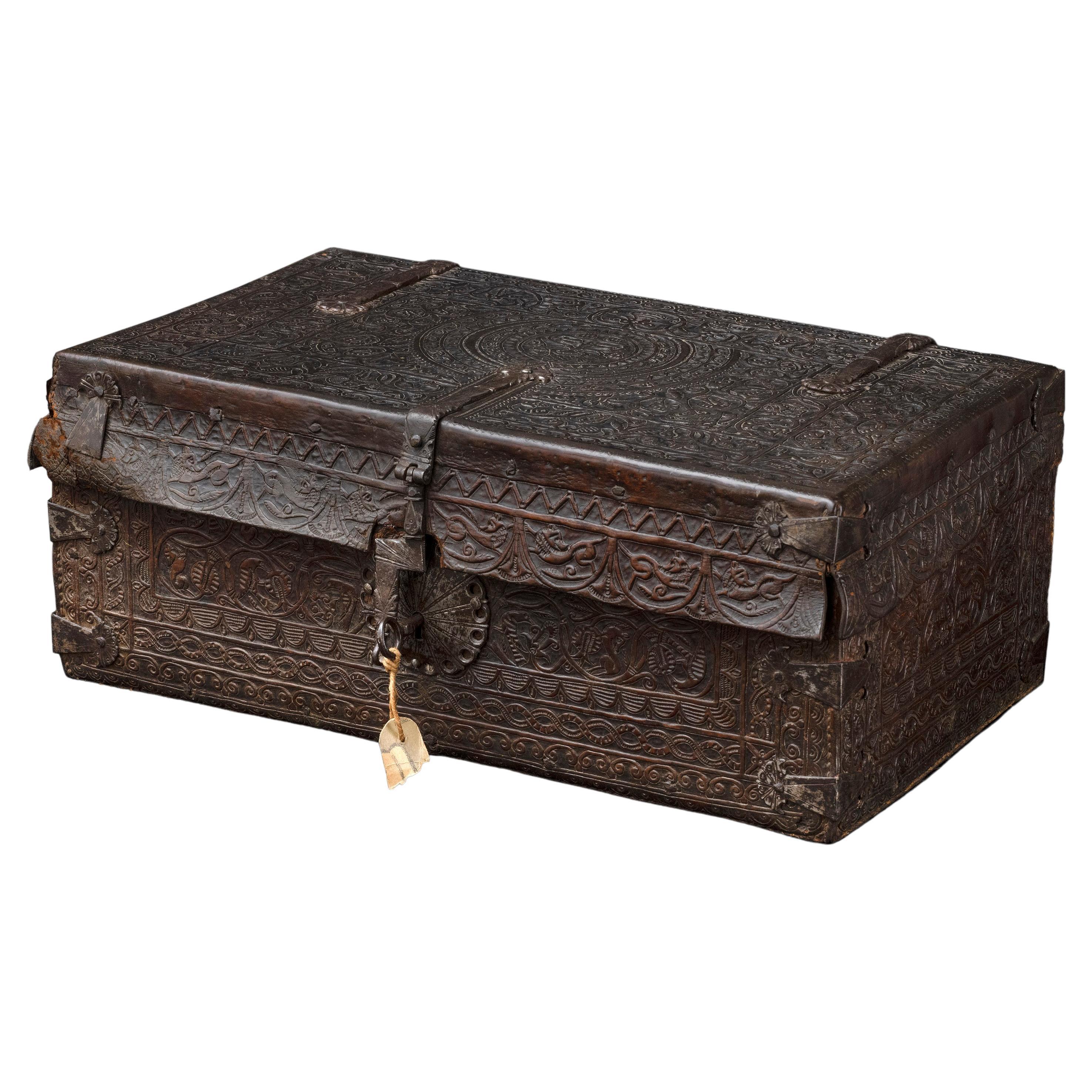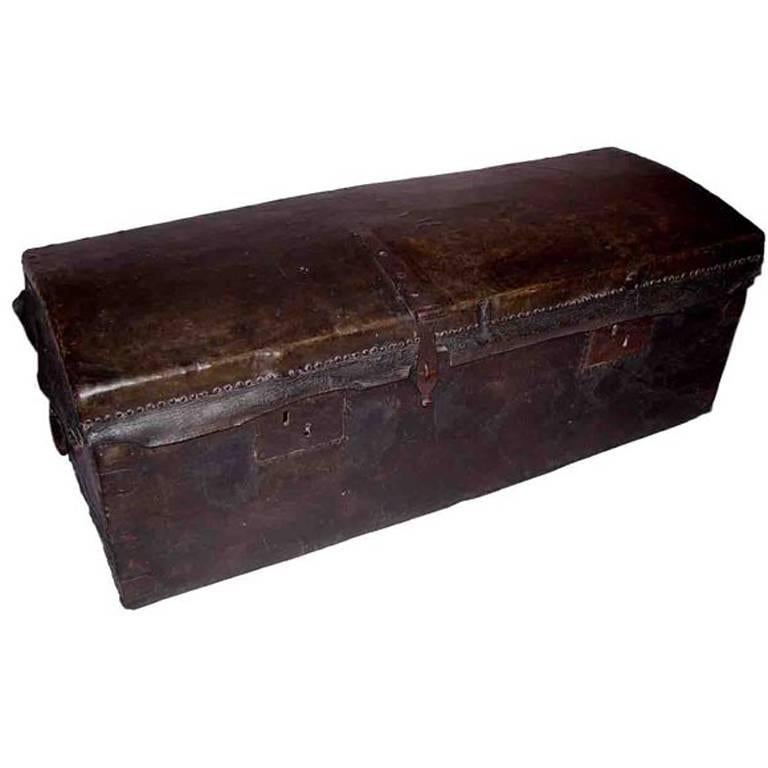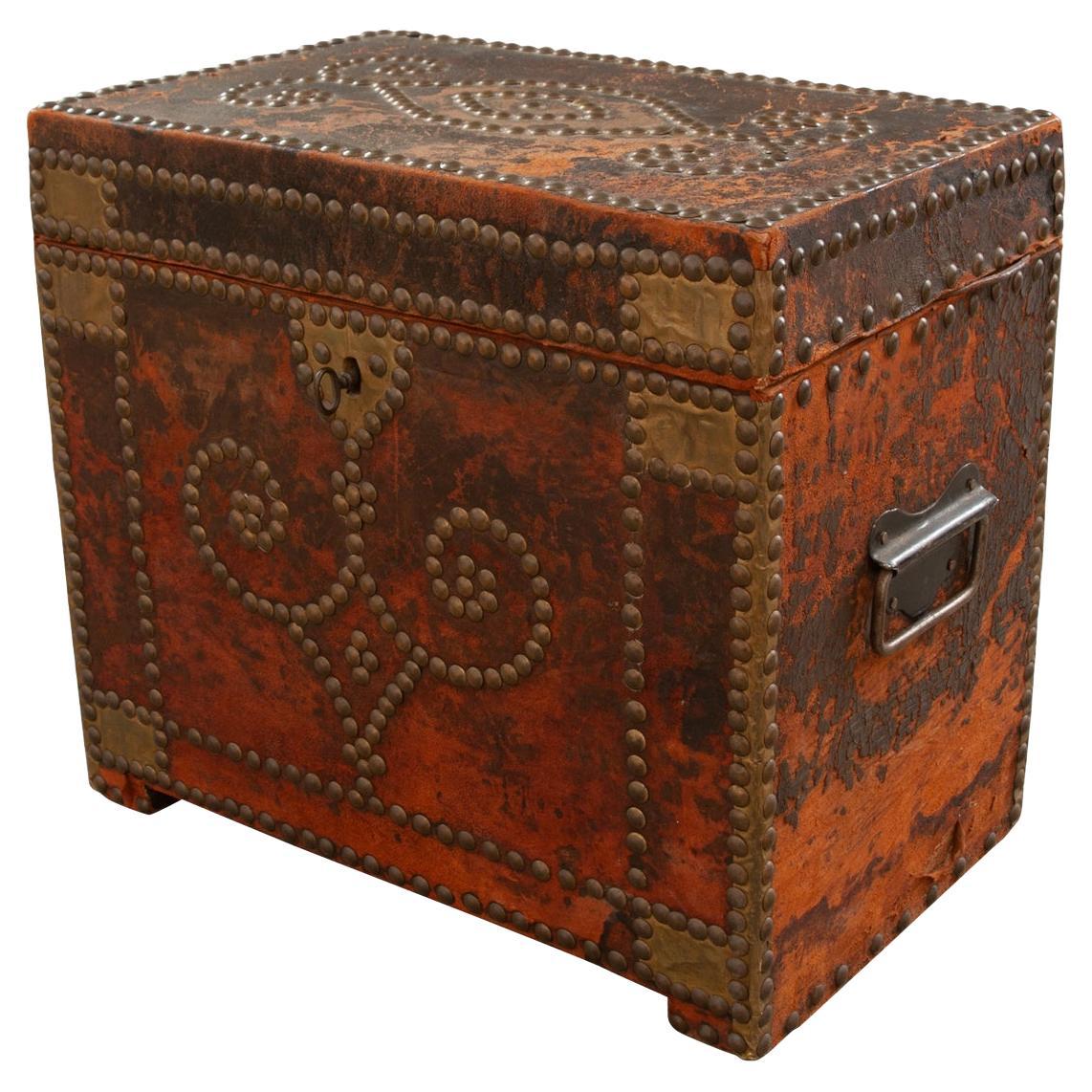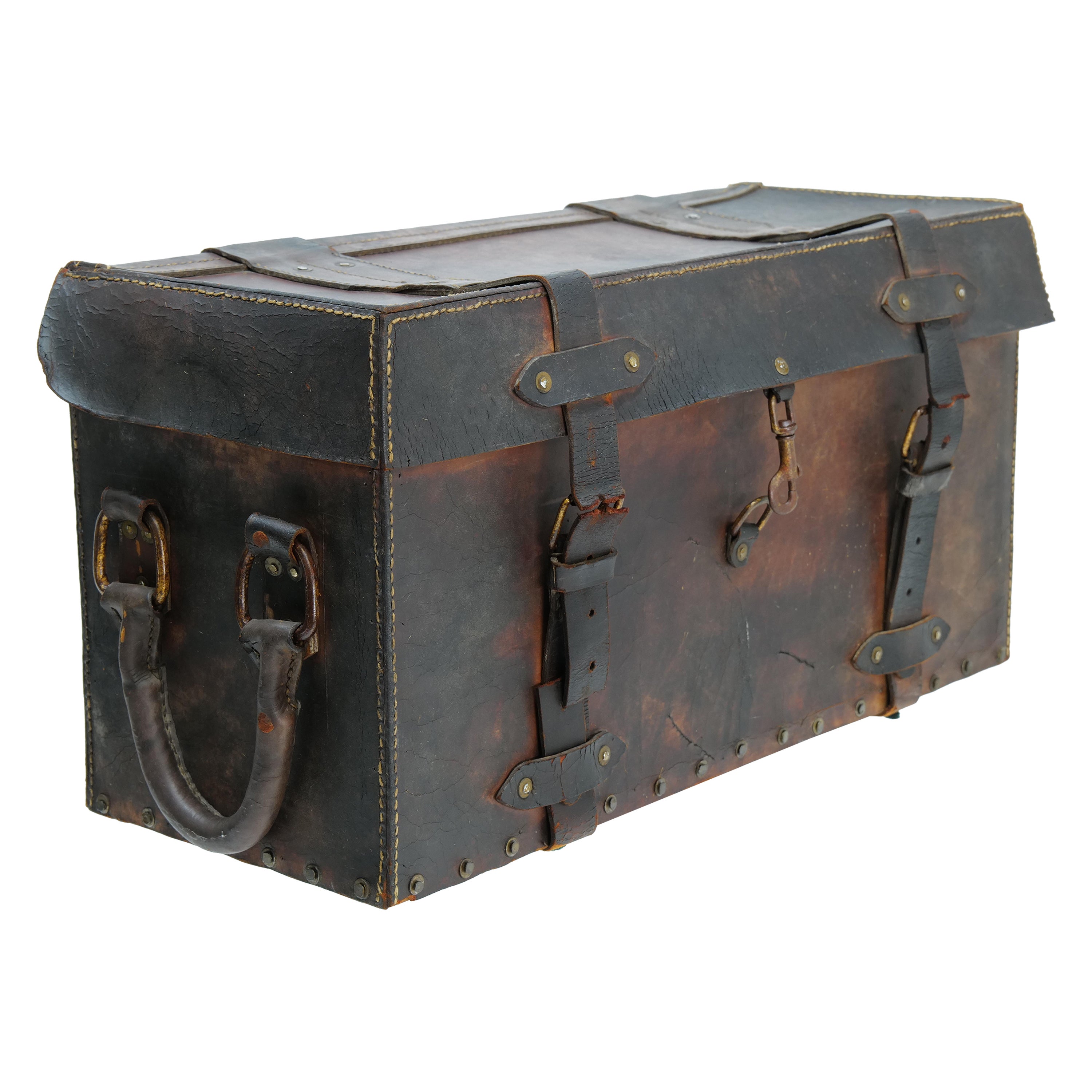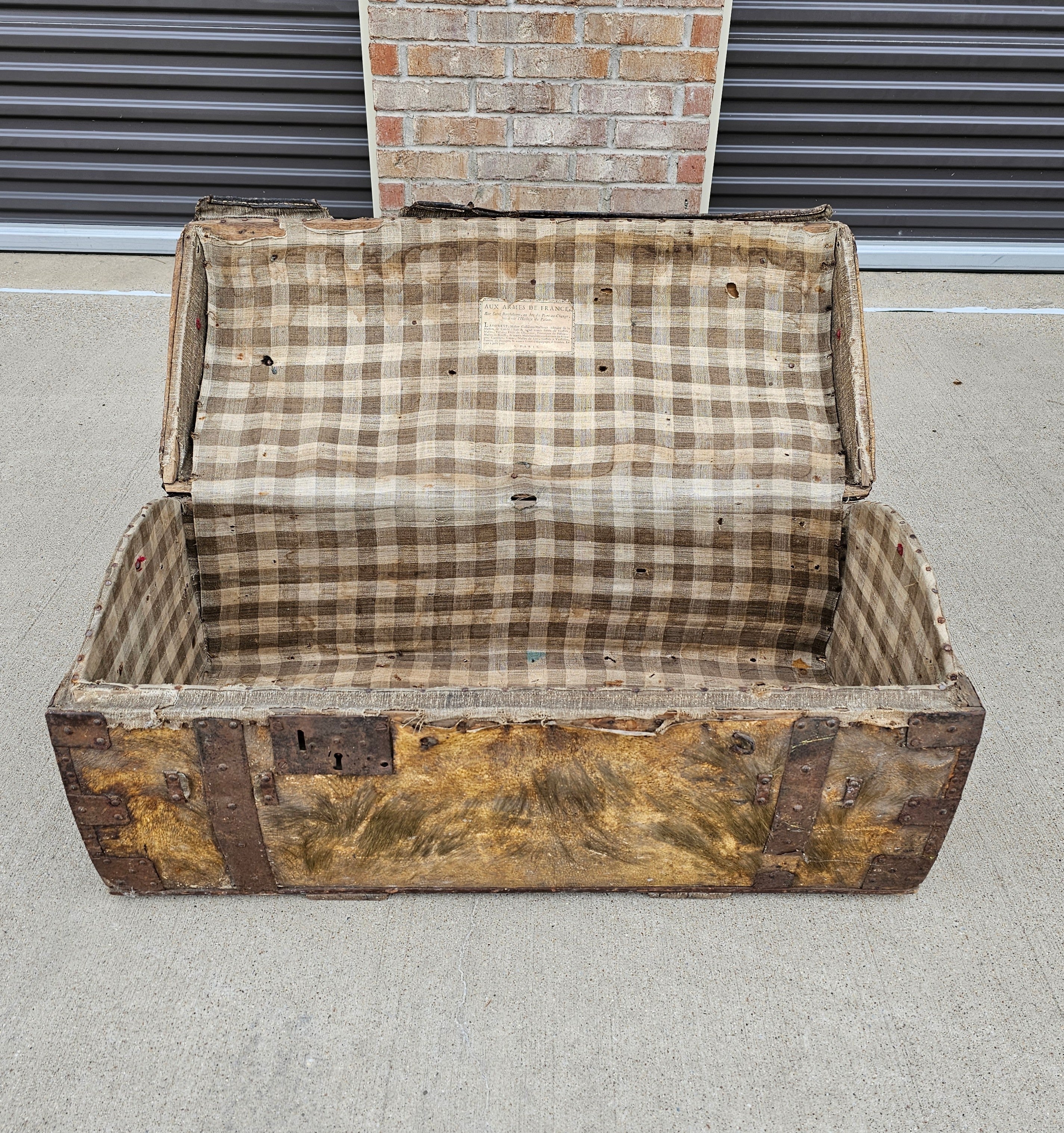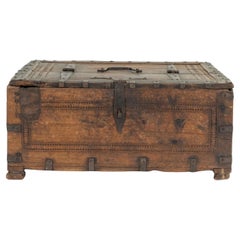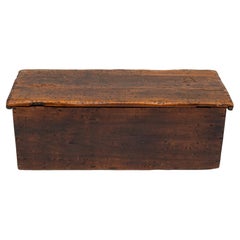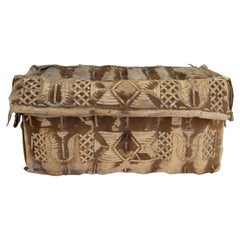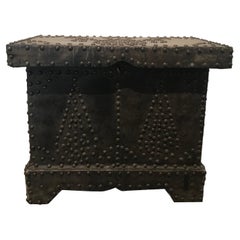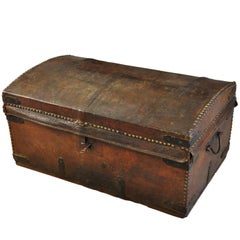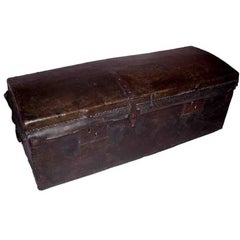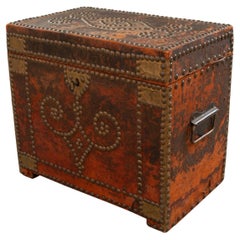Items Similar to 19th Century Leather Hide Trunk/Box found in the Frontier of Argentina
Want more images or videos?
Request additional images or videos from the seller
1 of 12
19th Century Leather Hide Trunk/Box found in the Frontier of Argentina
$680
£529.43
€602.11
CA$978.36
A$1,074.68
CHF 561.64
MX$12,816.48
NOK 7,111.83
SEK 6,625.27
DKK 4,499.24
About the Item
An evocative 19th-century Argentine travel chest, constructed with a wood carcass tightly wrapped in natural cowhide and reinforced with hand- forged iron strapping. The domed lid-designed to shed dust and moisture during overlap travel-retains its original brass handle and ironwork, including nail-studded bands and a robust lock plate with aged patina.
Likely used for personal effects or provisions during extended journeys, the chest reflects the hybrid material culture of rural Argentina in the 1800's, where European trunk-making traditions merged with local leather-working practices.
- Dimensions:Height: 8.5 in (21.59 cm)Width: 20 in (50.8 cm)Depth: 10.5 in (26.67 cm)
- Materials and Techniques:
- Place of Origin:
- Period:
- Date of Manufacture:unknown
- Condition:Wear consistent with age and use. Minor losses. Losses to skin due to age and usage. Structurally sound.
- Seller Location:Wainscott, NY
- Reference Number:Seller: MDPH12062021011stDibs: LU886846445222
About the Seller
5.0
Vetted Professional Seller
Every seller passes strict standards for authenticity and reliability
Established in 2007
1stDibs seller since 2010
191 sales on 1stDibs
Typical response time: 4 hours
- ShippingRetrieving quote...Shipping from: Wainscott, NY
- Return Policy
More From This Seller
View AllEarly 20th Century Afghani Carved Wood and Iron Storage Box
Located in Wainscott, NY
An early 20th century carved hardwood storage chest from Afghanistan, retains its original iron fittings and hardware. The rectangular form is defined by a deeply patinated surface a...
Category
Early 20th Century Afghan Primitive Decorative Boxes
Materials
Wood
19th Century American Primitive Travel Trunk in Handcrafted Pine
Located in Wainscott, NY
A charming and authentic example of early American craftsmanship, this primitive travel trunk dates to the 19th century. Likely handmade, the piece showcases a beautifully aged patin...
Category
Antique 19th Century American Trunks and Luggage
Materials
Wood, Pine
Early 20th Century Stencil-Cut Hide Box - Frontier Region of Argentina
Located in Wainscott, NY
The Argentine Hide trunk was found in the Frontier region of Argentina. The remarkable piece is an antique which brings a historical significance, noted by the intricate patterns of...
Category
20th Century Argentine Decorative Boxes
Materials
Hide
20th Century American Leather/Wood Studded Metal Trunk/Side Table
Located in Wainscott, NY
This handsome leather studded trunk with antique brass nailheads is a 20th Century American piece which is a decorative object or makes an incr...
Category
20th Century American Decorative Boxes
Materials
Metal
$1,481 Sale Price
25% Off
Early 20th Century Detailed / Tooled Leather Box from Morocco
Located in Wainscott, NY
Early 20th Century Tooled Leather Box from Morocco
Leather box was found in France.
The Workmanship of this piece is second to none.
Beautifully too...
Category
Early 20th Century Moroccan Decorative Boxes
Materials
Leather
Early 20th Century Small Tooled Leather Box from the Frontier Region / Argentina
Located in Wainscott, NY
Early 20th century small tooled leather box from Argentina
This small box has lovely tooled workmanship and its clearly handmade with care
Measure:...
Category
Early 20th Century Argentine Decorative Boxes
Materials
Leather
$280 Sale Price
20% Off
You May Also Like
Boiled Leather Trunk, Spanish, 17th Century
Located in Bruxelles, BE
Leather trunk
Spanish, 17th century
Boiled Leather, wood and iron
Measures: 22 x 53 x 32 cm.
Provenance :
- collection Metz-Noblat, Château de Clevant, France
Rectangular trunk of the form and size of a small suitcase with wrought iron hinges and lock-plate.
Wood, covered with leather, cut and embossed with every surface of the thick cow hide covered in interlace, zoomorphic features.
The construction method is boiled leather, often referred to by its French translation cuir-bouilli: a process used to change flexible, vegetable-tanned leather into rigid, moulded objects. For shaping of the vegetable-tanned leather, heat and moisture were used, as indicated by the term boiled leather. No written medieval sources describing the production of decorated cuir bouilli objects survive, so knowledge of the process relies on the important studies of the Scottish leather historian John William Waterer. A large range of methods, materials and techniques could be used in various combinations. The vegetable-tanned leather, made supple with moisture and heat, was stuffed, shaped and nailed to the rigid wooden coffer support. The stuffing material was probably modeled beeswax or stearin wax. To shape the leather, to create its topography, « Cushions » were made by lacing a thread through an awl hole and attaching the flexible leather and stuffing to the rigid wooden support on the bottom. Then the decoration was done: lines were incised through the upper layer of the leather (epidermis) with different thicknesses of knives or needles. Contours were created with deep v-shaped cuts, decoration with thin incision and final details with a needle point. For the incision and pouncing stage, the leather was probably kept heated and moistened for suppleness.
Once dry, the leather would be hard and rigid.
the saturated leather is worked over a form, possibly even damp sand, with the pattern shaped using bone or wooden tools. Compare to metal, leather was lighter and it offered protection from cuts and punctures. Cuir bouilli objects were produced by specialist leather workers and needed skillful craftsmanship.
The surface is filled with roundels shaped foliages enclosing animals, lions and peacocks. The foliate arabesques creating a vegetal connection tweet the animals create the impression of a lush verdant space . The vegetal pattern here employed in combination with geometrical pattern came from the pre-islamic artistic traditions of the Byzantine and Sasanian empires. An aspect of Islamic geometry Is the basic symmetrical repetition and mirroring of the shapes that create a sense of harmony.
The decoration of this truck is inspired by the islamic « arabesque » a form of vegetal ornament composed of spirals, intertwining plants and abstract curvilinear motifs. An arabesque character is given to the birds of the decorations through extreme stylisation. This arabesque maintained the classical tradition of median symmetry, freedom in Detail and heterogeneity of ornament.
The presence of the peacocks is a paradisiacal allusion: in popular Islamic literature they were among the original inhabitants of the garden of Paradise expelled with Adam and Eve. Peacock as a decorative motif may have originated in the West, despite their eastern provenance. There was an ancient belief that the flesh and feathers of peacock do not decay. This led to the peacock becoming a christian symbol for Christ’s resurrection.
Renowned for their decorative wall hangings, seventeenth-century Spanish leatherworkers also produced utilitarian objects, such as this trunk. A similar trunk is on display at the Metropolitan museum of art ( 09.158.1).
Related literature :
Davies L. 2006. Cuir bouilli. Conservation of leather and related materials, 94-102, Oxford: elsevier Butterworth-Heinemann
Grabar, Oleg. The Mediation of Ornament. Princeton: Princeton University Press, 1992
Gabriela Germana Roquez, "El mueble en el Peru en el siglo XVIII...
Category
Antique 17th Century Decorative Boxes
Materials
Iron
Mid-19th Century Italian Trunk
Located in Round Top, TX
A very handsome mid-19th century trunk, malle from Northern Italy. Wonderfully constructed from leather with iron bindings. Terrific patina.
Category
Antique Mid-19th Century Italian Trunks and Luggage
Materials
Leather
17th Century Leather Travelling Trunk
Located in Greenwich, CT
Rare 17th century leather wrapped traveling trunk with its original wrought iron carrying handles and clasp. Original hand-painted coat of arms still retained on interior of lid.
Category
Antique 18th Century and Earlier English Trunks and Luggage
Materials
Iron
English 19th Century Leather Trunk
Located in Baton Rouge, LA
We absolutely love this decorative trunk from England, wrapped in perfectly patinated Cordovan red leather adorned with brass studs in swirling patterns inspired by India. The lock is in working condition and includes one key. A pair of simple handles on each side make it easy to carry even when filled. The interior is lined with a (faded) red fabric that is fixed with leather cording to support the lid. Both decorative and functional, this unique petite trunk...
Category
Antique 19th Century English Anglo-Indian Decorative Boxes
Materials
Metal, Brass
Vintage French Leather Travel Trunk
Located in Oklahoma City, OK
This 1940s leather travel trunk exudes vintage charm, with a rich, timeworn patina that tells a story of countless journeys. The trunk’s deep brown leather has aged beautifully, deve...
Category
Vintage 1940s French Rustic Trunks and Luggage
Materials
Brass
Paris France Antique Hide Wood Iron Dome Trunk Chest, Signed, Early 18th Century
Located in Forney, TX
Patina perfection! A rare and incredible nearly 300 year old French Parisian trunk by La Forest in original condition!
An early precursor to the exceptional luxury leather artisans Paris is renowned, such as Hermès, Louis Vuitton and Goyard, we present this striking antique hide wrapped wood, iron, and flannel domed carriage travel trunk.
Exquisitely hand-crafted in Paris, France in the first half of the 18th century, during the reign of King Louis XV (1715-1774), showcasing fine quality craftsmanship, construction and luxurious materials, featuring a high quality solid wood frame reinforced with patinated metal mounts and strapwork, finished in raw animal hide binding to the top and front, flanked by hand forged rolled iron carry handles at the sides, slatted back and sturdy plank boarded verso, the narrow rectangular case having a hinged dome shaped top, opening to reveal the extraordinary rare original flannel fabric lined interior, retaining maker's label under lid, signed La Forest. circa 1725
The label reads:
Aux Armes De France
Rue Saint Barthelemy, au bas du Pont-au-change, vis-a-vis l'Horloge du Palais
La Forest, Maitre Coffretier- Malletier ordinaire de la Maifon de Condé : Fait & vend touted Fortescue de Coffres, Malles, Valifes, Etuis de Chapeaux, Fourreaux de Piftolets, Malles de Rouffi, & autres Marchandifes concernantles Voyages, Cantins, Caves, Malles de Lits, Coffres a Vaiffelles, Paniers de Bagages, & toutes Fortescue d'Equipages d'Armees. Le tout a jufte prix
A Paris
Translated:
Street Saint Barthelemy, at the bottom of Pont-au-change, opposite the Palace Clock...
Category
Antique 18th Century French Louis XV Blanket Chests
Materials
Wrought Iron, Iron
